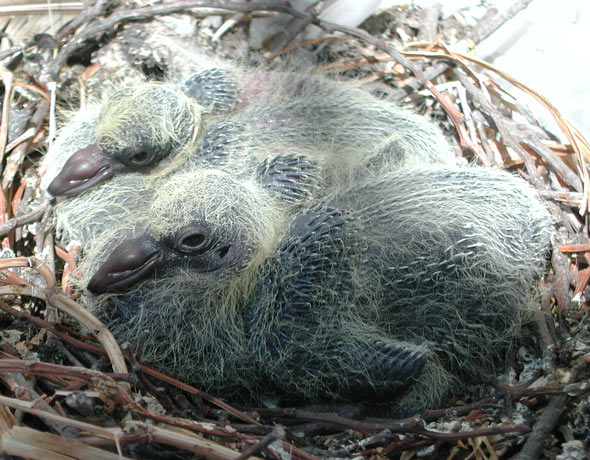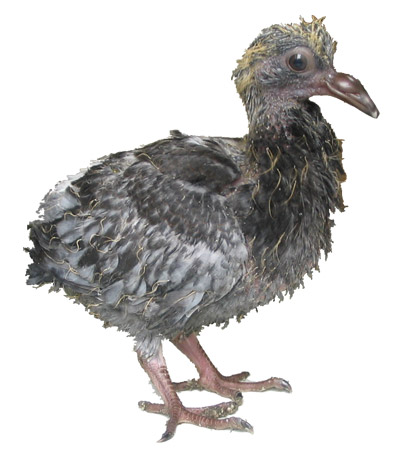 A ThatBirdBlog reader in Bangkok, Thailand recently contacted me concerning the hand-rearing of Zebra Dove nestling whose parents had been attacked by a crow. The incident reminded me that spring is on the way, and with it will come a number of calls concerning young pigeons and doves (or “squabs”), that have fallen from their nests or have otherwise become orphaned. Those who keep pigeons and doves as pets, or who “fly” them as a hobby, are also sometimes called upon to raise abandoned nestlings.
A ThatBirdBlog reader in Bangkok, Thailand recently contacted me concerning the hand-rearing of Zebra Dove nestling whose parents had been attacked by a crow. The incident reminded me that spring is on the way, and with it will come a number of calls concerning young pigeons and doves (or “squabs”), that have fallen from their nests or have otherwise become orphaned. Those who keep pigeons and doves as pets, or who “fly” them as a hobby, are also sometimes called upon to raise abandoned nestlings.
Crop Milk
Pigeons and doves depart radically from other birds when it comes to rearing their chicks. Rather than providing them with insects or fruit, breeding adults produce a semi-solid nestling food known as pigeon milk or crop milk. While not related to mammalian milk, there certainly are some parallels.
The “milk” is secreted from the lining of the crop, which is a food storage organ located at the end of the esophagus (base of the throat) of most birds. It is higher in protein (38%) and fat (58%) than both cow and human milk, and allows for very rapid growth. Crop milk also contains several vitamins and minerals, and is produced by both males and females.
Birds in several other families have also evolved a milk-like nestling food. Interestingly, that produced by Flamingos contains red and white blood cells.
Foster Parents
This is all very interesting, but the unique nature of crop milk renders it difficult to duplicate. Consequently, orphaned pigeons and doves can be troublesome to hand-rear.
In fact, at the Bronx Zoo I used Ring-necked Doves as “foster parents” for chicks of the highly-endangered Pink Pigeon…this proved far more effective than hand-rearing. By the time the Pink Pigeon squabs were ready to fledge, they were twice the size of their foster parents. I still do not understand how the little Ring-necks produced so much food (I was working on a “double-clutching” experiment at the time. The first Pink Pigeon clutch was pulled, so that the female would produce another batch of eggs.).
Artificial Crop Milk
 If you need to raise a squab and lack a foster parent, I suggest contacting a licensed wildlife rehabilitator (please see the National Bird Rehabilitatiors for help in locating someone). Squabs feed in an unusual manner, making it quite easy for beginners to introduce formula into the trachea rather than the esophagus.
If you need to raise a squab and lack a foster parent, I suggest contacting a licensed wildlife rehabilitator (please see the National Bird Rehabilitatiors for help in locating someone). Squabs feed in an unusual manner, making it quite easy for beginners to introduce formula into the trachea rather than the esophagus.
Folks with some experience may wish to try preparing their own crop milk. A formula known as MacMilk has proven very useful. It contains, among other ingredients, yogurt, egg yolk, baby food and cod liver oil. Please see the article below for instructions on its preparation and use.
Commercially prepared crop milk replacements are also sometimes available…check the National Pigeon Association or similar organizations for leads.
Further Reading
Crop Milk Replacer: Preparation and Use
Tropical pigeons and doves are growing in popularity among aviculturists…please see my article Three Spectacular Tropical Pigeons
for more info.
Feral Rock Dove Chicks in nest image referenced from wikipedia and originally posted by Aran Johnson
Columba livia 22 days old image referenced from wikipedia and originally posted by Mogor
 That Bird Blog – Bird Care and History for Pet Birds
That Bird Blog – Bird Care and History for Pet Birds




Thanks so much for this information. A dove squab came into my posession and the information here was invaluable in my being able to keep him alive and healthy. Here is a post O made about my little bird! http://xgreenxeyesx.blogspot.com/2011/07/0-hand-feed-baby-bird.html
Hello Heather, Frank Indiviglio here.
Thanks for your interest in our blog and the kind words. Congrats on your success…not an easy task by any means. Your blog post on the experience is quite interesting and should be helpful to others.
Please let me know if you need any further information. Good luck, enjoy and please keep me posted.
Best regards, Frank Indiviglio.